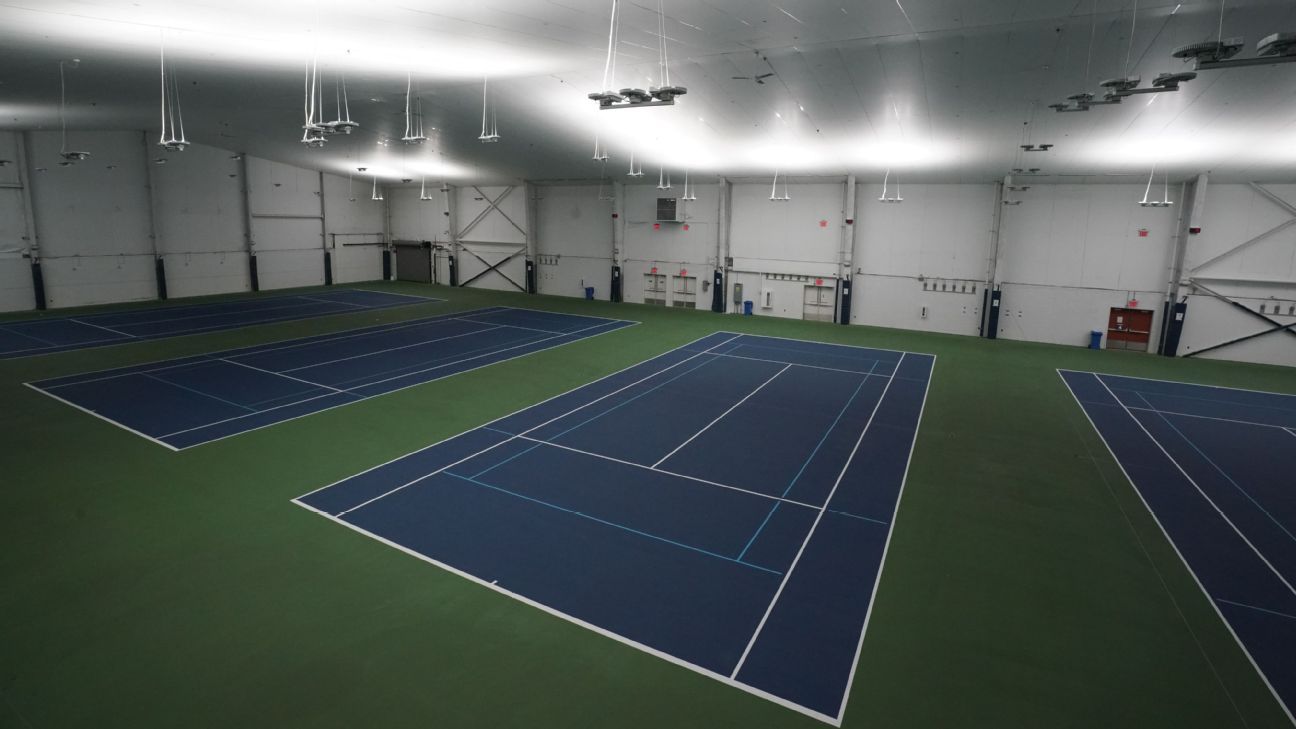Barely seven months ago, scores of fans milled around the grounds of the USTA Billie Jean King National Tennis Center during the US Open. Inside the exclusive, air-conditioned hospitality zone at the site’s Indoor Training Center, lobster rolls and steak were served alongside flutes of champagne.
This week, the same hangar-like facility where lucky tennis fans dined in luxury is rapidly being converted into a 350-bed temporary hospital to relieve the pressure on nearby Elmhurst Hospital, just four miles away and the epicenter of the coronavirus pandemic in Queens, New York. The hospital is overwhelmed with patients suffering from COVID-19.
“It’s ironic, to say the least,” Danny Zausner, the NTC’s chief operating officer, told ESPN on Thursday. “And it seems so trivial to be thinking about the tennis right now. This is just a small part of the overall picture, but it helps and it’s the least we can do.”
The NTC hospital facility is being built on the fly by SLS, a company based in Galveston, Texas, that does general contracting and construction with a specialty in aiding disaster relief efforts. The hospital will be one of the first pop-up emergency facilities capable of treating those suffering from COVID-19, in addition to accommodating patients needing hospital care for non-coronavirus related illnesses or conditions.
“They [SLS] are one company that brings it all in,” Zausner said. “Beds, materials to construct rooms, doctors, nurses and respiratory equipment. We [NTC personnel] are here to support them because we have the contacts when it comes to plumbing, HVAC and those kinds of things. We can tell them how their trucks can access the site from the [public] park.”
The NTC occupies more than 45 acres on the grounds of the 1964 World’s Fair in Flushing Meadows-Corona Park. The Indoor Training Center, which is situated near the East Gate and across from the new Louis Armstrong Stadium, is one of the few original structures left on the site, although it has been renovated and added to. The 12 practice courts are covered and repurposed during the US Open into, among other things, the “fan experience” zone as well as hospitality dining.
Now those courts will provide nearly 100,000 square feet of supplemental hospital space.
Touring the site on Tuesday, New York Mayor Bill de Blasio told reporters: “We need it now. It [the National Tennis Center] should not be sitting there doing nothing. This is a war effort. Everybody needs to contribute.”
The USTA has been a willing partner with the city from the start. Barely a week ago, officials with the New York City Office of Emergency Management began seeking out structures large enough to be transformed into emergency hospitals. The Aqueduct Racetrack, also in Queens, was selected along with the National Tennis Center.
Initially, the city was interested in the main Arthur Ashe Stadium, the world’s largest dedicated tennis stadium (capacity, 23,700). But a very small portion of the roofed stadium’s interior volume (the floor of Ashe takes up just 6,000 square feet) is suitable for hospital use.
While Ashe remains idle, the new, high-tech Louis Armstrong Stadium has also been repurposed. The NTC’s second roofed arena, introduced at last year’s US Open, has less available floor space than Ashe but enough to host a critical enterprise related to the pandemic. It is already operating as a food packaging and distribution center.
Crews in Armstrong, working two different shifts between 6 a.m. to 11 p.m six days per week, are packaging meals for COVID-19 patients, workers at the city’s various crisis centers and underprivileged children who customarily rely on breakfast and lunch provided at school. (New York public schools were closed by de Blasio on March 16.)
“The city needs to provide in excess of 100,000 meals per day,” Zausner said. “Our crews are producing about 25,000 boxes of food a day. Each of those boxes contains six meals, which is supposed to last a person for two days. So we’re making about 150,000 meals per day.”
USTA officials still plan to hold the US Open, traditionally the last Grand Slam event of the year, for two weeks starting Aug. 24. Shortly after All-England Club officials announced the cancellation of Wimbledon on Wednesday, the USTA released a statement that said: “We understand the unique circumstances facing the All England Lawn and Tennis Club and the reasoning behind the decision to cancel the 2020 Wimbledon Championships. At this time the USTA still plans to host the US Open as scheduled, and we continue to hone plans to stage the tournament.”
That plan assumes that the NTC will no longer be functioning as a temporary hospital, but it’s unknown if that will be the case come mid-August.
“We’re a tenant of the [New York] city,” Zausner said. “We’re here to support the city and support Queens. They understand the importance of the US Open, an economic engine that generates some $800 million each year. As an overflow for Elmhurst, it’s assumed that as soon as they get ahead of the [coronavirus] curve, they can get back to being a regular hospital. It’s not like Elmhurst will end up empty and we’ll be full.”
Ultimately, some potential US Open visitors might be concerned that the ITC will remain contaminated and pose a threat after the hospital has been disassembled. Zausner is confident that won’t be the case.
“We’ll all want to return to normalcy as soon as possible,” Zausner said. “A lot of the early stage work involves putting protective coverings on the floors and other exposed areas. The ITC will be sterilized when the time comes to break down the hospital. It will probably end up being cleaner than it’s ever been.”
